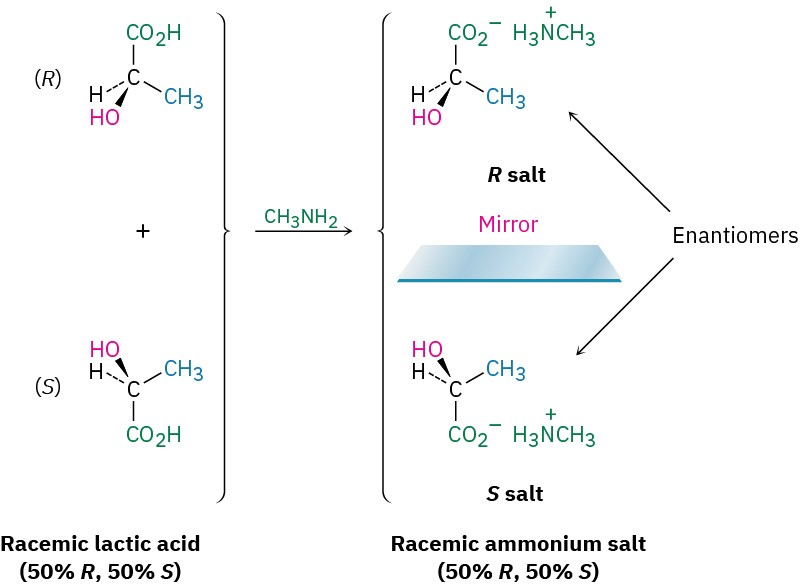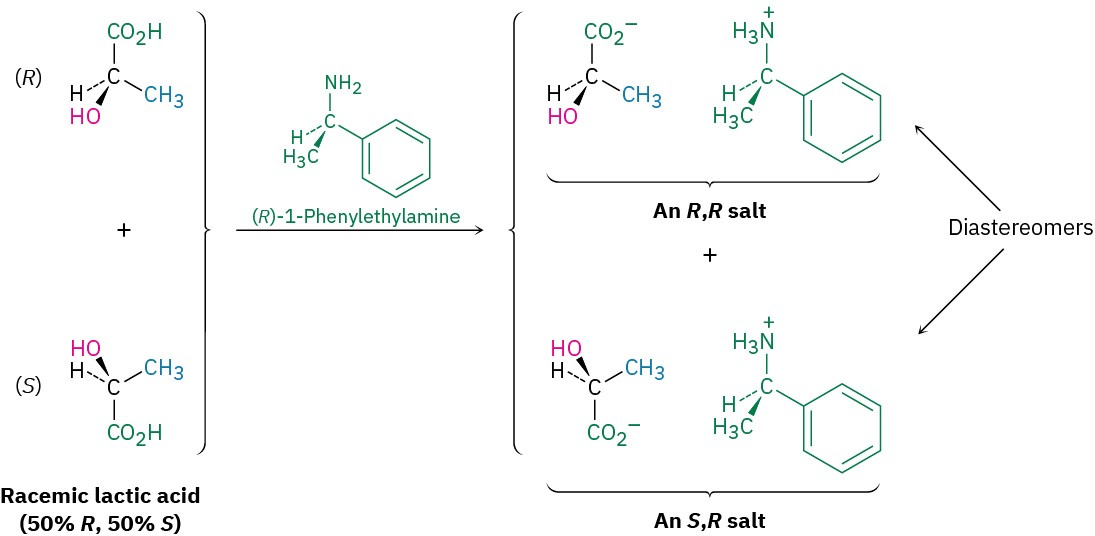5.8 Racemic Mixtures and the Resolution of Enantiomers
To end this discussion of stereoisomerism, let’s return for a last look at Pasteur’s pioneering work, described in Section 5.4. Pasteur took an optically inactive tartaric acid salt and found that he could crystallize from it two optically active forms having what we would now call 2R,3R and 2S,3S configurations. But what was the optically inactive form he started with? It couldn’t have been meso-tartaric acid, because meso-tartaric acid is a different chemical compound and can’t interconvert with the two chiral enantiomers without breaking and re-forming chemical bonds.
The answer is that Pasteur started with a 50 : 50 mixture of the two chiral tartaric acid enantiomers. Such a mixture is called a racemate (rass-uh-mate), or racemic mixture, and is denoted by either the symbol (±) or the prefix d,l to indicate an equal mixture of dextrorotatory and levorotatory forms. Racemates show no optical rotation because the (+) rotation from one enantiomer exactly cancels the (−) rotation from the other. Through good luck, Pasteur was able to separate, or resolve, racemic tartaric acid into its (+) and (−) enantiomers. Unfortunately, the fractional crystallization technique he used doesn’t work for most racemates, so other methods are needed.
The most common method for resolving the racemate of a chiral carboxylic acid (RCO2H) is to carry out an acid-base reaction between the acid and an amine base (RNH2) to yield an ammonium salt:

To understand how this method of resolution works, let’s see what happens when a racemic mixture of chiral acids, such as (+)- and (−)-lactic acids, reacts with an achiral amine base, such as methylamine, CH3NH2. The situation is analogous to what happens when left and right hands (chiral) pick up a ball (achiral). Both left and right hands pick up the ball equally well, and the products—ball in right hand versus ball in left hand—are mirror images. In the same way, both (+)- and (−)-lactic acid react with methylamine equally well, and the product is a racemic mixture of the two enantiomers methylammonium (+)-lactate and methylammonium (−)-lactate (Figure 5.13).

Figure 5.13Reaction of racemic lactic acid with achiral methylamine gives a racemic mixture of ammonium salts.
Now let’s see what happens when the racemic mixture of (+)- and (−)-lactic acids reacts with a single enantiomer of a chiral amine base, such as (R)-1-phenylethylamine. The situation is analogous to what happens when left and right hands (chiral) put on a right- handed glove (also chiral). Left and right hands don’t put on the right-handed glove in the same way, so the products—right hand in right glove versus left hand in right glove—are not mirror images; they’re similar but different.
In the same way, (+)- and (−)-lactic acids react with (R)-1-phenylethylamine to give two different products (Figure 5.14). (R)-Lactic acid reacts with (R)-1-phenylethylamine to give the R,R salt, and (S)-lactic acid reacts with the R amine to give the S,R salt. The two salts are diastereomers, not enantiomers. They have different chemical and physical properties, and it may therefore be possible to separate them by crystallization or some other means. Once separated, acidification of the two diastereomeric salts with a strong acid makes it possible to isolate the two pure enantiomers of lactic acid and to recover the chiral amine for reuse.

Figure 5.14Reaction of racemic lactic acid with (R)-1-phenylethylamine yields a mixture of diastereomeric ammonium salts, which have different properties and can be separated.
Worked Example 5.6Predicting the Chirality of a Reaction ProductWe’ll see in Section 21.3 that carboxylic acids (RCO2H) react with alcohols (R′OH) to form esters (RCO2R′). Suppose that (±)-lactic acid reacts with CH3OH to form the ester, methyl lactate. What stereochemistry would you expect the product(s) to have? What is the relationship of the products?
 SolutionReaction of a racemic acid with an achiral alcohol such as methanol yields a racemic mixture of mirror-image (enantiomeric) products.
SolutionReaction of a racemic acid with an achiral alcohol such as methanol yields a racemic mixture of mirror-image (enantiomeric) products.

Problem 5-19
Suppose that acetic acid (CH3CO2H) reacts with (S)-2-butanol to form an ester (see Worked Example 5.6). What stereochemistry would you expect the product(s) to have? What is the relationship of the products?

Problem 5-20
What stereoisomers would result from reaction of (±)-lactic acid with (S)-1- phenylethylamine, and what is the relationship between them?

